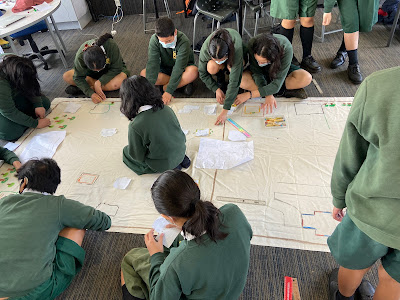Monitoring, Recording and Tweaking
Monitoring: Following our work on Ahi Ka, Bastion Point and the recording of interrogational events throughout the process it became apparent my audio recordings were not showing the improvement I had anticipated.
The historical study began at Michael Joseph Savage's legacy, his burial at Bastian Point and finished at the conclusion of the land occupation. I broke the study into two distinct areas:
The non fiction and the fiction.
The non fiction included reading and researching this historical time frame looking through old newspaper clippings, movie reels and journals. During this time we hot seated the Crown to find out why they actioned the burning of the homes on Bastion Point. The Crowns response left the students angry and frustrated. Now that the students knew the history of the area we could move into the fictional side.
The fictional aspect focussed on the emotions and feelings running through the characters involved. It required the students to step into their shoes, take on the lives of the people involved. We hot seated members of the community and Joe Hawke himself. The students could see the whole issue began with the Crown torching homes on Orakei Reserve. Their question was 'why?' They decided to plan a community, present it to the Crown, with evidence and reasoning, in an effort to stop the destruction and removal of the Ngati Whatua People.
The Plan began with deciding what the people needed, what they wanted and making sure Tikanga was also considered. Houses were designed that were healthy and safe. The homes and other facilities were designed on graph paper to scale. There was a marae, kura, playgrounds, community gardens, orchards and a walking track around the whole area. But something was missing! After research into diseases such as rheumatic fever, measles, meningitis, bronchiectasis and cellulitis the decision was made to plan for and design a medical centre.
Throughout this time the language was rich and the research and design aspects focussed on the job at hand.
Finally, teams presented their designs to the class and followed through with questions/interrogation and response time. Audio recordings of this did show a slight improvement in questioning and responding but not with much extension. I noted that it could have been due to the fact the groups were continuously discussing their research and planning within the classroom for all to hear. Maybe there was no need for in-depth questioning? I have also considered the movement between non fiction and fiction. Did this allow for the students to have more of a historical understanding and less reason to question? Had many gaps in understanding already been filled in?
Tweaking: I'm still hopeful there will be improvement! I'm now planning to add in more opportunities for hot seating to further strengthen the skills required to interrogate with depth and consistency by integrating more fictional situations. We are also in the middle of an inquiry unit where a NZ hero is being fully researched and will eventually be hot seated... a non fictional process. The audio recordings from these two differing situations may back up my wondering as to whether non fiction vs fiction plays a role in the level of interrogation students are able to respond to.





Comments
Post a Comment